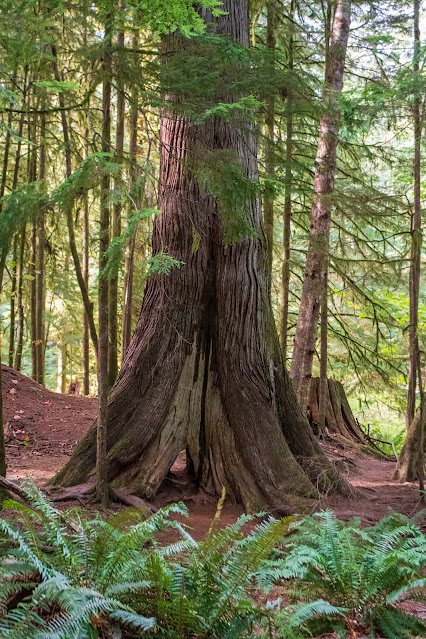Many of the larger red-cedar* trees in the forest above the Campbell River have cavities at the base, large enough to provide shelter for small animals, and sometimes large enough for a big bear.
We stopped to look inside one of these.
 |
| The view from the trail. |
I went around back to see where the hole came out.
 |
| There's a whole room inside there! |
 |
| The opening is maybe 4 metres high; the hole inside goes on up into the darkness. |
 |
| And the tree is still healthy, with its green crown held high up in the sunlight. |
These holes make the trees a valuable resource for forest dwellers. The hollowed-out trees can still live and thrive; the heartwood is dead wood and the outer layers maintain the circulation of nutrients and water. The Stanley Park Hollow Tree in Vancouver was around 800 years old when it finally lost its crown.
"Over time, butt- and trunk-rot fungi often create the large cavities and hollow trunks that are so highly valuable to wildlife. The western red-cedar can survive with a higher ratio of decayed wood to living wood than any other B.C. tree species, and relative to most tree species, hollow trunks are comparatively common in western red-cedars of sufficient age. ...their wood provides better heat insulation than that of any other conifer species. ... black bears seek out the hollow trees for use as dry, warm hibernation dens."
Bears, birds, bats, beetles; the residents in an old red-cedar may include raccoons, woodpeckers, brown creepers, sapsuckers and chickadees, cedar bark beetles and weevils. And skunks, but not here on the island. So far.
*About the name: "Most authorities ... transliterate the English name in two words as 'western redcedar', or occasionally hyphenated as 'western red-cedar', to indicate that it is not a true cedar (Cedrus), but it also appears as 'western red cedar' in some popular works." (Wikipedia) I had been calling it "red cedar" but will use the better red-cedar in future. It's species name is Thuja plicata
~~~~~~~~~~~~~~~~~~~
Muchos de los grandes cedros rojos, Thuja plicata, que se encuentran en el bosque en las laderas a lo largo del rio Campbell, tienen huecos en la base de suficiente tamaño como para proporcionar albergue a animales pequeños, y a veces hasta animales grandes como los osos.
Nos detuvimos para mirar una de estas cavidades.
Fotos:
- El árbol, visto desde el sendero. Tiene una apertura que parece penetrar hacia el lado opuesto.
- Visto desde el otro lado; hay todo una habitación adentro.
- La apertura mide aproximadamente 4 metros, y el hueco sigue encerrado hacia arriba.
- El árbol sigue vivo y sano; la corona se alza hacia la luz del sol en lo alto.
"Pasando el tiempo, hongos que pudren la base y el tronco muchas veces crean las grandes cavidades y troncos ahuecados que son tan valiosos para la fauna silvestre. El cedro rojo occidental puede sobrevivir con una proporción más alta de madera podrida a madera sana que cualquier otra especie de árboles de Columbia Británica, y con respeto a la mayoría de especies de árboles, los troncos ahuecados son más comunes en los cedros rojos occidentales de edad suficiente ...su madera provee mejor aislamiento contra el calor, comparada con la de todas las otras especies de árboles coníferos ... los osos negros buscan los árboles ahuecados para usarlos como guaridas de hibernación secas y cálidas."

No comments:
Post a Comment
I'm having to moderate all comments because Blogger seems to have a problem notifying me. Sorry about that. I will review them several times daily, though, until this issue is fixed.
Also, I have word verification on, because I found out that not only do I get spam without it, but it gets passed on to anyone commenting in that thread. Not cool!